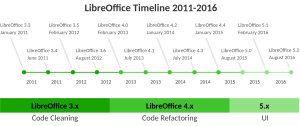 Last time I wrote about Slackware Live Edition was when I released the version 1.1.0 of the scripts. And that was two months ago; lots of updates have been made inbetween. Today I released version 1.1.3 of ‘liveslak’.
Last time I wrote about Slackware Live Edition was when I released the version 1.1.0 of the scripts. And that was two months ago; lots of updates have been made inbetween. Today I released version 1.1.3 of ‘liveslak’.
I made a set of ISO images (during the last couple of days actually… it is time-consuming) for the Slackware Live Edition based on liveslak 1.1.3 and using Slackware-current dated “Thu Aug 11 18:24:29 UTC 2016“. These ISO images have been uploaded and are available on the primary server ‘bear‘.
If you already use a Slackware Live USB stick that you do not want to re-format, you should use the “-r” parameter to the “iso2usb.sh” script that allows you to refresh the liveslak files on your USB stick without touching your custom content.
Remember, to find out what’s on the ISO you downloaded, try this command:
$ isoinfo -d -i your_downloaded.iso | egrep “Volume id|Publisher id|Data preparer id|Application id”
And if you want to know what ISO was used to create your USB stick, check the content of the /.isoversion file in the root of its Live partition (partition number 3).
As usual, you will find ISO images for a full Slackware (64bit and 32bit versions), 64bit Plasma5 and MATE variants and the 700MB small XFCE variant (64bit and 32bit versions).
New in the ISOs
Most obvious of course: the ISOs are based on the latest slackware-current with Linux kernel 4.4.17. That’s exactly what you’ll get with the SLACKWARE variant.
The XFCE variant’s ISO is ever so slightly larger than the official CDROM size specification dictates, but it should still fit hopefully… I will try to remove some more unneeded stuff before the next release. As it stands, the addition of tigervnc, cups and hplip to the XFCE ISO made it necessary to apply some aggressive pruning of ISO content to be able to stay below the 703 MB limit.
The MATE variant has a refreshed ‘msb‘ package content, I synced my local ‘msb‘ mirror with the official package repository at http://slackware.uk/msb/14.2/
The PLASMA5 variant is a bit of a special case this time. Take note of the following before you download it.
- I added the LXQT and Lumina Desktop Environments. Both are light-weight DE’s based on Qt5 so they look nice & shiny. The Plasma 5 packages inside the ISO already satisfy most if not all of their dependencies. So now there’s two new desktop environments for you to try out. Let me know what you think of them!
One word of caution when using the Lumina DE:- the network applet is not enabled by default, and you may have to enable the network manually. I used “nmtui” in a terminal window but you can try enabling the networkmanager-applet instead. I did not find out how, yet.
- I decided to base this release of PLASMA5 Live on a new ‘testing‘ branch of my ktown repository for slackware-current. This ‘testing‘ branch is not yet public because it contains some intrusive changes. It may have an adverse effect on your Slackware desktop. Why? Because my new ‘testing’ repository will be investigating Wayland support, and this is a work in progress, i.e. stability is not guaranteed.
I think that as long as you do not attempt to start a “Plasma (Wayland)” session but stick to the default “Plasma” session, everything will work properly. But in order to compile support for Wayland into KWin, I had to do the following and you will understand that not everybody will want to follow – so that is why I provide this on a safe Live environment only:- rebuild Slackware’s ‘mesa’ package with wayland support
- rebuild Slackware’s ‘xorg-server’ package with wayland support
- add an ‘elogind‘ package. Elogind is the systemd project’s ‘logind’, extracted out to be a standalone daemon… quite similar to the ‘eudev’ package we already have in Slackware.
- rebuild the ‘qt5’ package to add wayland support
- build KWin on top of this all (it requires full wayland support all the way down to X.Org and it also requires a working logind implementation) to get a functional ‘kwin_wayland‘ executable.
- I took the opportunity to upgrade Qt to 5.7.0 and upgrade to KDE Frameworks 2.25.0, Plasma 5.7.3 and the all-new Applications 16.08.0.
I am still pondering how to maintain a separation between two ‘latest‘ and ‘testing‘ repository branches. I plan to offer ‘latest’ as a bleeding edge Plasma5 but without the intrusive stuff like rebuilt mesa and xorg but I worry about the workload when also offering a ‘testing’ package set. I may have to reconsider my monthly release schedule of the ktown updates. And the git repository will have to be branched as well (the least of my worries).
In any case, this latest Slackware PLASMA5 ISO is definitely worth checking out.
In the first place it allows you to get a look at the latest Plasma and Applications, and then there’s the Wayland support. If you are interested in getting Wayland working on Slackware I really appreciate your help!
Because (big fat warning): Wayland is not working properly yet. The “Plasma (Wayland)” session gets stuck in a black screen when started from SDDM and when you start it from the console (select the ‘xinitrc.kwayland‘ entry in ‘xwmconfig‘) it seems to run in a framebuffer at a fixed 1024×768 pixel resolution.
The changes between liveslak scripts 1.1.2 and 1.1.3
Not so much has changed actually – small fixes and enhancements. The ‘1.1.3’ tag was applied to accompany the release of the new ISOs.
- iso2usb.sh: add safeguard against mistyping the LUKS passphrase.
- make_slackware_live.sh: add ‘-G’ parameter to generate ISO image from pre-existing file tree.
- liveinit: allow modules to be organized in subdirectories.
- XFCE: add tigervnc, cups and HP printer support.
Download the ISO images
The ISO variants of Slackware Live Edition are: SLACKWARE, XFCE, PLASMA5 and MATE. These ISO images (with MD5 checksum and GPG signature) have been uploaded to the master server (bear) and should be available on the mirror servers within the next 24 hours.
- Primary location: http://bear.alienbase.nl/mirrors/slackware-live/ (rsync://bear.alienbase.nl/mirrors/slackware-live/)
- Darren’s mirror (also fast!): http://slackware.uk/people/alien-slacklive/ (rsync://slackware.uk/people/alien-slacklive/)
- Willy’s mirror: http://repo.ukdw.ac.id/slackware-live/
- Ryan’s mirror: https://seattleslack.ryanpcmcquen.org/mirrors/slackware-live/
- Shasta’s mirror: http://ftp.slackware.pl/pub/slackware-live/ (rsync://ftp.slackware.pl/slackware-live/)
- Tonus’s mirror: http://ftp.lip6.fr/pub/linux/distributions/slackware/people/alien-slacklive/
Download liveslak sources
The liveslak project can be found in my git repository: http://bear.alienbase.nl/cgit/liveslak/ . That’s all you need to create a Slackware Live ISO from scratch. Documentation for end users and for Live OS developers is available in the Slack Docs Wiki.
Have fun! Eric


Recent comments